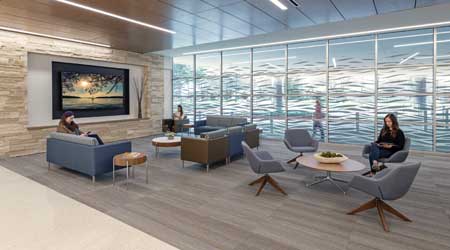Biophilic Design, Smart Systems Lead to Happier Patients, Better Outcomes
Adding elements of nature and incorporating them with technology can help bring positive outcomes for patients in healthcare facilities.
Although it is not a new concept, biophilia has gained traction in the last few years, especially in healthcare design. The idea that human beings are drawn to and react positively toward green spaces seems self-evident, but the practice has begun to quantify tangible metrics, and this has had a major impact on design.
Data from “The Economics of Biophilia,” a report by the consulting firm Terrapin Bright Green, bear out the multitude of benefits this type of design can provide in the retail space. For instance, shoppers’ perception of the value and quality of goods increases proportionately to the level of greenery and vegetation within a space. As such, they are more likely to accept higher prices. And don’t forget — people like natural light as much as plants do. Stores with a high level of daylighting can realize boost profit margins by 15 to 20 percent.
Of course, the goal in healthcare is not to increase profit margins, but the application is self-evident: Biophilia hastens the healing process and transforms what can be a forbidding, disorienting environment into a positive, uplifting space.
Indeed, research supports the idea that when patient rooms have views of nature, postoperative stays are generally shorter, less pain medication is dispensed, and overall condition improves. A study by researchers Katcher, Segal, and Beck found that patients waiting to undergo dental surgery showed lower anxiety levels when an aquarium of fish was present in the waiting area as opposed to when the aquarium was absent.
Benefits are not limited to “real nature” but can be achieved by representational depictions. Evidence shows that photographic images of nature (landscapes, gardens and waterscapes) can also reduce stress and improve results like pain relief.
Smart systems
While the move to more calming, natural environments continues, so does the ever-growing clinical need for new technology, and this is likely the next frontier for healthcare architects and designers. While Moore’s Law (speed and capability will likely double every two years) is certainly at play in the type of equipment hospitals require for current treatment protocols, we are starting to see an increasing level of sophistication in the building systems, which have no small role in the patient experience. Anything that can be done to remove stress or disorientation contributes to a more positive and enriched experience.
A recent project, the University of California San Francisco’s Bakar Precision Cancer Medicine Building, is a next-generation example of how the seamless integration of technology into a healing environment elevates not only the provision of care but also the overall patient experience. Patients check in just once at a centralized registration, and a real-time location system allows them to move around without fear of missing an appointment, getting lost, or wandering down the wrong corridor. The systems also helps boost the level of efficiency in scheduling treatments, meaning more patients are treated more efficiently, reducing wait times as well as frustration levels.
Related Topics:













